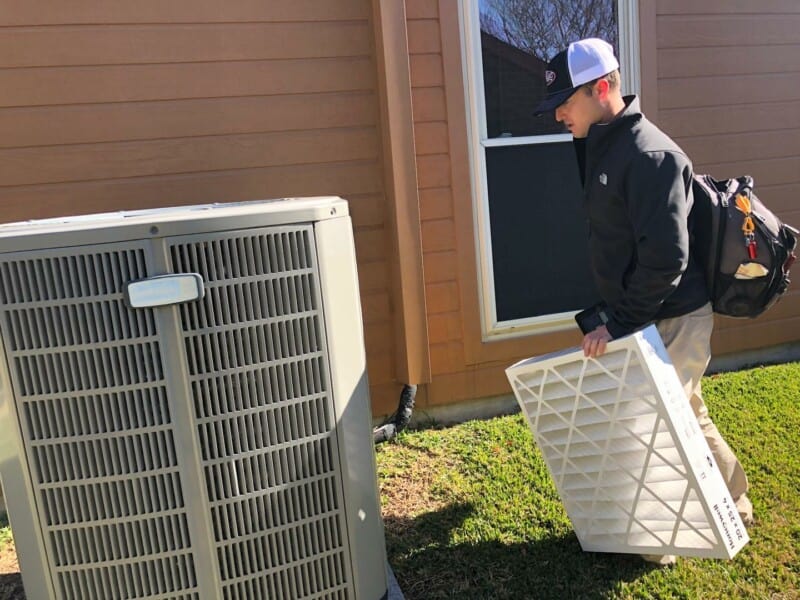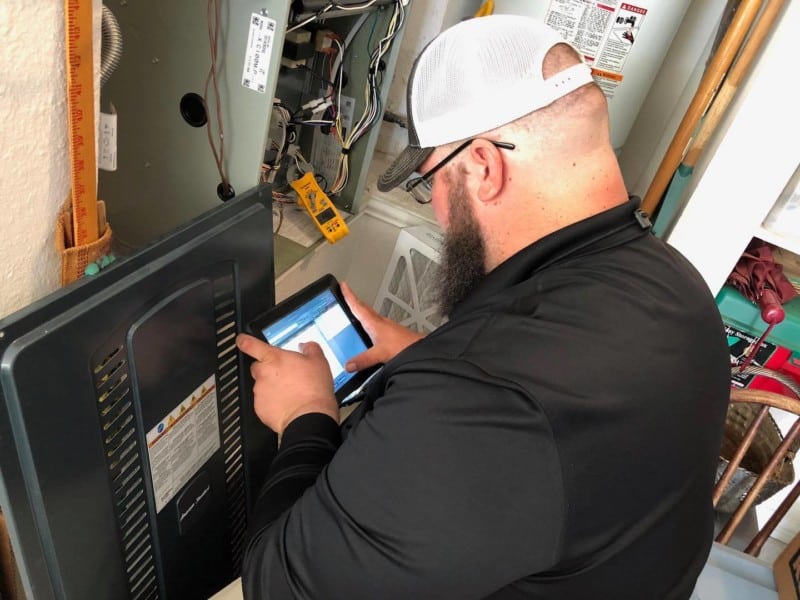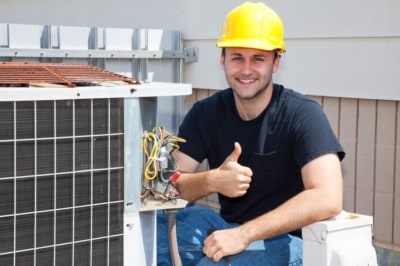The HVAC system is designed to achieve residential and commercial buildings’ environmental requirements (heating and cooling). Heating, ventilation, and air conditioning (HVAC) are interrelated primary functions of a heating and cooling system to provide quality indoor air and temperature for acceptable comfort.
It may come as no surprise that this complex system requires regular maintenance to function efficiently. HVAC maintenance is essential to prevent the need for major repairs or entire replacements, which can be very expensive.
What steps should one take to maintain a productive and efficient HVAC system?
First of all, most HVAC companies suggest an inspection/tune-up twice a year. If an HVAC system keeps up with its regular recommended tune-ups, then your system can last for years to come.
In this article, we are going to share with you why HVAC Inspection is so important.
You’ll discover how this not only saves money in the long run but actually extends your HVAC’s lifespan, increases safety and efficiency factor, improves air quality and comfort, and helps the environment.
Here are some of the most common questions we receive about HVAC inspections that we’ll be answering in this article.
- What are the types of HVAC inspections available?
- When should I schedule an HVAC maintenance visit?
- How much does an inspection cost?
- What happens during an HVAC tune-up?
- What are the most common problems a tune-up reveals?
- Can I conduct an HVAC inspection myself?
- How do I find the right HVAC technician?
The HVAC Inspection: Why Is It So Important?
Many individuals know just what an investment the HVAC units are but generally fail to maintain them properly.
A good maintenance plan includes a full HVAC inspection twice yearly to ensure that the heating and AC system is in optimum condition when you need it the most.
An HVAC system will only function properly when regular HVAC inspections and tune-ups are done. Here are just a few benefits to a proper functioning HVAC system:
Save money
Regular maintenance means repair problems can be spotted and solved early on. The maintenance prevents costly breakdown, reduced energy bills, and less frequent emergency repairs. Not to mention, warranty repairs are easier to get covered the earlier problem is identified.
Maximizing the system’s lifespan
Routine HVAC inspections can prolong your system’s lifespan, therefore lengthening the time between replacements and keeping it in better condition longer. It also means a reduced likelihood that you’ll need to spend big bucks on a new HVAC installation.
Increasing safety
Regular HVAC inspections can reveal safety issues that could endanger facilities and where people are living or working. Hazardous issues such as short circuits can cause serious damage to home, health, and property. It also helps safeguard against the risk of carbon monoxide exposure.
Efficiency Factor
A well-maintained HVAC unit will likely run with excellent efficiency with little energy, which means less wear and tear on the HVAC unit’s parts.
Improve your air quality and comfort
A properly maintained HVAC unit keeps you comfortable all year round. It produces and distributes evenly and steadily warm or cool air. It also prevents problems with air quality, such as respiratory problems caused by dirt, mold, or bacteria.
Helps the environment
Once an HVAC system is maintained correctly, it considerably consumes less fuel and reduces your system’s impact on the environment.
Regular maintenance provides technicians with the opportunity to spot potential issues, along with economical benefits.
An HVAC inspection checklist is a tool that helps ensure the quality and the proper functioning of your system.
Consider the following particulars that will be helpful to point out to a technician before an inspection begins.
- any recent maintenance
- any repairs in the last 10-15 years
- high energy bills
- inconsistent airflow
- discomfort in winter and/ or summer seasons
- more allergy symptoms than usual
- strange odors or sounds
- thermostat malfunctions
What Types of HVAC Inspections are Available?
There are different types of HVAC inspections:
- HVAC Tune-ups – These tune-ups follow a multi-point inspection of your air conditioner (in the spring) and heater (in the fall). A thorough tune-up along with maintenance usually prevents breakdowns.
- HVAC Repair – After inspecting that your HVAC system isn’t cooling or heating correctly, this type of HVAC inspection generally focuses on fixing the problem.
- HVAC Inspection – this is a type of HVAC inspection without maintenance service. This type provides a detailed written audit of the equipment’s age, how the system was installed, its performance, and a list of any recommended repairs or improvements.
- Preventive HVAC Maintenance – Preventive precautions are taken to avoid replacement and heating and cooling repair costs for your HVAC system components.
Each type of Inspection has its own HVAC inspection checklist, but the general areas that should always be included are:
- Basic functioning of heat pumps, furnaces, and air conditioners
- Thermostat calibrations
- Blower components
- Proper airflow through the entire system
- Installation quality (whether installed originally by you or another HVAC business)
- Overall condition of already installed equipment
- Test venting and clearance
- Test combustion air
- Check air filter
- Inspect electrical connections
- Inspect areas equipment location
- Inspect equipment condition
- Inspect evaporator coils and condenser for air conditioning units
- Evaluate system starting capabilities
- Test safety controls
- Evaluate temperature differentiation
- Test refrigerant pressure
- Examine condensate drains and drip pan
- Examine air conditioning and heating equipment versus air handler for a proper match
- Assess heat pump heating mode and defrost cycle
- Evaluate operation of backup heating source
- Examine heat exchanger, ignition, and burner assemblies
- Test venting and clearances
- Test gas pressure and piping
The expert technician you hire may have their own HVAC Inspection checklist, but the important thing is that they are fully inspecting your unit, vents, and thermostat thoroughly.
What Happens During an HVAC tune-up?
There are many aspects to becoming a homeowner, which include HVAC inspections. To enjoy safe, problem-free home comfort all year round, a biannual HVAC service with your trusted heating and cooling company is the best way.
An HVAC inspection will identify areas where cleaning, repairs, or replacements could overall benefit your home in terms of heating and cooling efficiency.
As a rule of thumb, you should be present during these inspections.
During a tune-up, your technician ensures that your system optimally works and keeps you updated on the age, condition, and possible upgrades available for your system. In some situations, they may need to walk you through a maintenance procedure or discuss necessary repairs.
While every HVAC system is unique, it is essential to have a qualified technician service and inspect your unit.
What will they be checking when they are servicing your HVAC?
AC Inspection
- Review cooling performance, temperature drop and determine if adjustments are necessary.
- Probe outdoor condenser coil and remove debris from the unit.
- Inspect condenser fan motor operation and lubricate if necessary.
- Check the amperage of the compressor for proper operation.
- Test operation and condition of compressor contractor.
- Inspect and tighten electrical connections.
- Inspect start/run capacitors and relays.
- Inspect for refrigerant leaks.
- Inspect indoor evaporator coil, if accessible.
- Flush condensate drain to protect against overflow.
- Check out blower assembly operation, lubricate and adjust if necessary.
- Check the condition of air filters and other indoor air quality accessories.
- Safety tests all controls for proper operation.
- Adjust the thermostat if necessary and confirm proper operation.
- Evaluate overall efficiency of the system and inform you of equipment condition
Heating Inspection
- Clear heat exchanger if necessary and inspect for combustion leaks.
- Test for carbon monoxide.
- Adjust and clean burners for maximum efficiency if necessary.
- Inspect thermocouple and clean pilot assembly where applicable.
- Inspect and clean flame sensor.
- Examine flue and inspect the venting system
- Verify proper inducer motor operation.
- Verify proper ignition and record ignitor resistance reading.
- Inspect gas piping and valve for gas leaks.
- Flush condensate drain to protect against overflow if applicable.
- Check out blower assembly operation, lubricate and adjust as necessary.
- Examine the condition of air filters and other indoor air quality accessories.
- Safety tests all controls for proper operation.
- Adjust the thermostat if necessary and confirm proper operation.
- Evaluate the overall efficiency of the system and inform you of equipment conditions.
Once there is an identification of any problems from checking the basic and testing the system’s capacities, the technician can better proceed to the common next steps:
- Repair or replace an HVAC system
- Incorporate recommended accessories.
- Learn about proper maintenance
- Plan or schedule routine HVAC tune-ups
Depending on the current condition of your HVAC unit, possible upgrades can be added, such as:
- Leak prevention
- Surge protectors
- Air purifiers and extra filtration
- WiFi or other smart thermostats
When should I schedule an HVAC maintenance visit?
Most of the time, when an HVAC company recommends maintenance, you might think it’s unnecessary. Unless there is something seriously wrong with either your cooling or heating system, you may be tempted to put off calling a technician.
However, just like any other equipment, no matter what kind of HVAC system you have, it should be inspected, cleaned, and serviced.
For homeowners with a newer HVAC system, yearly inspections are sufficient, but for those who live in severe weather patterns, bi-annual inspections are wise.
If you live in an older home or have an HVAC system reaching the end of its lifetime, a more regular HVAC inspection is advised.
The best scenario is to schedule maintenance service before you need your system the most. So, your heating system is checked during the fall season and an AC inspection during the Spring.
In terms of cleaning the system from debris, and tasks related to possible damage or leakage of refrigerant lines, those are best done monthly to maintain optimal functionality of the system.
If you noticed these ten tale-tell signs, it is advised to call your technician.
- Insufficient cooling or heating. The uncomfortable temperature could indicate a faulty system and may need to be checked by your HVAC technician.
- Increased energy bills. Under normal circumstances your utility bills should maintain a certain level of consistency throughout a given season. If you notice an unusual spike, this could signify that your HVAC system is having problems and needs maintenance.
- Heating unit blowing cold air. There are numerous reasons why your heating system could be blowing cold air. One of the most likely causes is clogged air filters which block heated air from entering your home.
- Poor airflow. It could be due to a blocked duct, clogged filters, a malfunctioning motor, or a faulty compressor.
- Your system is running constantly. The thermostat typically controls when the units are supposed to kick in when needed and go off when the conditions are right.
- Strange smells. A correctly functioning HVAC unit should not have any odor or smell coming out of it.
- Unusual noises. In the proper working condition, an HVAC system will make low-level noises during start-up and when shutting down, but it doesn’t make any loud or unusual noises.
- Frequent issues and repairs. It is normal to experience issues once in a while. But when frequent breakdowns occur, these could indicate a bigger problem that needs to be discussed with your HVAC expert.
- Water leaking from the air conditioning unit. It could indicate problems within the drain tube or the condenser unit. It can also be due to a leaking refrigerant which might pose severe health risks to your family.
- The system continually goes on and off. Correctly working units should never run indefinitely. It could be a sign that your thermostat has some problems.
Cost of HVAC Inspection
An HVAC inspection is generally relatively inexpensive as long as you are keeping up with the preventative maintenance such as replacing air filters on a routine basis.
It may be worth it to consider high-efficiency air filters which are about $20 a piece. If you are not sure which filters to purchase, ask your HVAC technician for their recommendation.
If you hire a technician to do an HVAC tune-up, expect to spend around $50 to $100 per visit.
If repairs are exposed during the inspection, that will cause the price of HVAC visit to increase.
Here are some average HVAC repair costs, according to HVAC.com:
- Repair blower motor: $150
- Replacement blower motor: $450
- Thermostat replacement: $50 to $200+
- Replacement ignitor: $300 to $400
- Repair flame sensor: $80
- Replacement flame sensor: $250
- Repair heat exchanger: $100
- Replacement heat exchanger: $500 to $1,200
- Repair pressure sensor/circuit board: $50
- Replacement pressure sensor/circuit board: $350
- Replace gas valve: $150
- Replacement smart valve: $750
- Replacement draft inducer: $150 to $450
Note that these costs are averages, and they can vary depending on your system’s type and age.
Contractors across the country also price differently, but it is also wise to be honest with your contractor regarding your budget. If you want a more accurate price or personalized quote on a particular HVAC service, contact your trusted company.
Can I Conduct a DIY HVAC Inspection?
Unless you’re a licensed HVAC technician, chances are you won’t have the right skills and knowledge to perform an inspection that is as thorough and sharp-eyed as a professional would.
However, you will gain an advantage by understanding what technicians look for when inspecting your HVAC system. Similar to the HVAC inspection checklist, you should keep a list of items to regularly check as you examine your own unit.
To help prevent expensive and inconvenient breakdowns, you can perform regular inspections on your unit using the following steps.
- Start with the thermostat. Check whether it is working correctly, both for the heating and cooling mechanisms.
- Shut off the power. This is a crucial step as you will be removing parts of the unit. Find the correct switch on your breaker box and turn off the power to the inside unit. On the outside unit, turn off the on/off switch.
- Remove debris from the external HVAC unit. After detaching the fan cage from the top of the unit, use a wet/dry vacuum to remove any excess leaves or debris from the interior.
- Clean and repair the fins. Use a sprayer hose and not a pressure washer to wash away any debris.
- Clean the area around the unit. A good rule of thumb is to keep at least two feet of distance between your external unit and any vegetation in its surroundings.
- Level the unit. Your external unit can sometimes shift over time. If a condenser isn’t leveled, this can cause the compressor to fail much earlier than it should.
- Clean the evaporator coil. Give your evaporator coil on your internal unit a good dusting. Then spray over it a no-rinse coil cleaner.
- Replace the filter regularly. Clogged filters are one of the most common causes of HVAC malfunction, creating some major problems.
While HVAC systems are designed to run on their own with little intervention from you, keeping your system regularly maintained can make a big difference.
HVAC Maintenance Checklist
- Use a high-efficiency furnace filter. Newer, pleated filters are practical at grabbing tiny particles that carry bacteria.
- Check the filter monthly. If it looks dirty, replace it. Even if you don’t think you need to, replace it every 90 days.
- You might need to close your house’s air registers to direct the air where you need it most, but don’t close more than 20% of your registers because it will put extra strain on the HVAC equipment.
- Check out your outdoor units (air conditioners and heat pumps), ensuring that leaves, pollen, branches, grass clippings, or other items don’t block the area.
- While you’re evaluating the outdoor units, also be sure that there are two feet of clearance on all sides and level on the ground or platform.
- Periodically inspect insulation and refrigerant lines. If they are damaged or missing, replacing them is advised.
- Turn off the furnace’s humidifier in the summer. When you turn it on in the fall, replace the humidifier wick filter and set the humidistat to the optimal setting (as recommended in the owner’s manual), before turning on the water supply.
It’s also recommended to have an annual professional inspection, even if you think you can do it yourself. HVAC equipment is costly and complex, and it’s a good idea to have it inspected annually.
Sometimes, things go awry, even in well-maintained systems. Fortunately, there are tricks for heater troubleshooting and DIY AC repair that even a novice, like yourself, can use to diagnose a problem.
DIY: HVAC repair
Here are the most common furnace problems to look for:
- Thermostats
Check the thermostat; the problem might be as simple as replacing the batteries. Or, if it’s programmable, a brief power outage or surge could have changed the programming. In that case, that device could be what’s affecting your heat or air conditioning problem.
- Power switches
HVAC power switches can be easily mistaken as regular light switches and are usually located in your attic or basement. It is worth checking whether any switches have been flipped.
- Air filters
Common furnace problems can arise simply from forgetting to change the air filters. When the air filter is clogged, the furnace is working harder to pump the air through the house. When the furnace is working hard, it’s more likely to break down.
- Condenser unit
Maintaining the condenser, the outdoor “box” that runs your central air conditioner, means ensuring that the airflow is unrestricted.
- Circuit breakers
An overheated air conditioning unit can overload your system and trip the breaker. If this happens, you can just switch the breaker back to its normal position. However, if it happens often, you might want to contact a professional rather than DIY.
Air conditioner maintenance tips
Central air conditioner maintenance doesn’t have to be a chore. These maintenance tips help you keep cool.
- Filters: Filters, filters, filters! Some filters can be cleaned and reused, and others need to be replaced regularly.
- Air conditioner coils: Condenser coil and evaporators collect dirt. While clean filters help, it’s still an essential part to maintain clean coils.
- Coil fins: Those aluminum fins on your condenser require to be checked for bends and dents. You can purchase a “fin comb” that can straighten out the bent fins.
- Drains: Snaking the drain channels for your condenser should be part of your regular HVAC maintenance checklist. Clogs cause excess moisture, which could discolor your walls or carpet.
- Get professional maintenance: Although you might want to do it yourself, HVAC systems usually require a once-per-year overhaul by a professional.
HVAC DIY: Furnace repair
There are two constant components to DIY HVAC maintenance: (1) routine maintenance to keep the system running smoothly and (2) troubleshooting if something goes wrong.
The HVAC maintenance tips above are a good start to keeping things going, but there are a few things that you can do specifically for your furnace.
- Check the circuit breaker. If you suddenly have a “dead” furnace or blank thermostat, the first thing to do is see if you’ve blown a fuse. Have your breaker box labeled at each switch so that you know immediately if the furnace switch is off.
- Check the furnace switch. The switch on the furnace should be set to “heat”.
- Check the pilot light. If your pilot light is located in a drafty area, it’s possible that it could have blown out. Close doors or windows, or block a draft, and then safely relight it. If this does not work, it’s possible that you have a clogged pilot opening.
- Reset ignition control. If your furnace has an electric ignition, you can do a “reboot” by turning the thermostat down or the power switch to “off.” Give it a few minutes, and then turn everything on again to reset.
- Be aware of gas leaks. A gas leak is an emergency and you must contact the fire department as soon as you are outside the home and in a safe location. If you smell natural gas, or if your CO2 detector sounds, leave the house immediately and leave windows and doors open for ventilation. If you can, safely turn off the gas supply valve, usually located near your gas meter on the inlet pipe. Rotate the valve one-quarter turn using a wrench. If you suspect a gas leak, do not light any matches or touch any switches until you have the all-clear from the utility or fire department.
How to choose an HVAC technician near you.
It is uncommon to have HVAC issues regularly, but they should be addressed immediately if a problem occurs.
Waiting to fix the issue can lead to unnecessary stress and discomfort in your home and lead to health problems if you are not careful.
Additionally, the more you put off your problem, the more it will cost you on hiring an HVAC technician.
Don’t be intimidated by looking for HVAC technician. Here are our top tips to hiring the best HVAC technician in town.
- Recommendations – reach out to friends and family members who live in the area on whom they go for their HVAC support and why.
- Do a general search – conduct follow-up research on HVAC company names you were given and check if they service your area of town. Take your time in exploring the recommendation to ensure you get the most current, accurate information.
- Read client reviews and testimonials – this will help you understand what to expect from the services you get from a technician. Classic Heating & Air has received over 500, 5 out of 5-star customer local reviews on their website.
- Checking for licensing – check if the company is recognized for rewards or has additional licenses in other areas, such as Classic Heating and Air. Our company is an awardee of the American Standard Heating & Air Conditioning Celebrates 2019 Winners of the Building a Higher Standard Awards.
- See how long an HVAC company has been in business – a safer bet is to go to a company with a more experienced option. Like Classic Heating and Air, which have been in the industry since the mid-1980s, their foundation and reputation were built on professionalism, customer relationships, and old-fashioned service. These ideals and philosophies, along with their core values, are the main reason why the company is one of the most recognized, trusted HVAC service providers in North Texas.
- Look for any additional home repair services – they may also specialize in other things such as plumbing, electricity, and gas services. Or they might have experience with commercial and residential properties. Classic Heating & Air offers both residential and commercial HVAC services.
- Get a quote for the services you need – reach out to the company you think you want to hire to get a better feel for the technicians who may be working on your HVAC unit. You can gauge how much you trust them and how well prepared they are to handle your HVAC issues. Classic Heating & Air phone lines are open 24/7, so whether your situation is an emergency or a well-planned event, they will be there when you need it most. They have plenty of service trucks within the metroplex, so their technicians are never far away. They even guarantee service within two hours, or it’s free!
- Talk specifics and ask questions – you want to find out how experienced their technicians are and how knowledgeable they are about the situation in your home and the best way to fix it.
- Bring up brands – double check that they’re knowledgeable about the kind of HVAC unit you have and that they’re able to supply all the necessary parts to make repairs.
- Get everything in writing – ask for a list or form before each technician leaves from their consultation. These documents can help you keep track of numbers, make comparisons, and refer back to any possible upcharge or accidentally double charge.
If you’ve been curious about HVAC around Northern Texas, then Classic Heating & Airhas got you covered. They provide the best equipment, best warranty, and best customer services in McKinney, Plano, and Dallas metroplex. For more information, visit their website at https://www.classicheatandair.com/, or give them a call at 214-851-2824.






